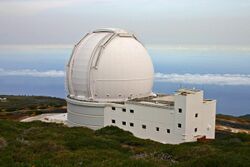Astronomy:PlanetPol
PlanetPol was a ground-based, high sensitivity polarimeter based at the William Herschel Telescope[1] on the island of La Palma in the Canary Islands, Spain that has now been decommissioned. It was the most sensitive astronomical visual polarimeter ever built in fractional polarisation, a mantle that since its decommissioning now belongs to HIPPI. Although the device could be used for a wide range of astronomy, its primary use was the detection of extrasolar planets.[1]
Results
PlanetPol did not discover any extrasolar planets, however it was used to provide upper limits to planetary albedos in the known 55 Cnc and τ Boo planetary systems.[2] Observations with the polarimeter in the Canary Islands, which are affected by dust from the Sahara, also identified airborne dust as a source of polarization within our atmosphere.[3] Additionally, PlanetPol provided measurements of the polarization of a few dozen nearby stars,[4] which were later combined with southern hemisphere measurements from PlanetPol's successor, HIPPI,[5] to provide information about the nature of those stars and the distribution of the interstellar medium.[6]
References
- ↑ 1.0 1.1 Hough, J. H.; Lucas, P. W.; Bailey, J. A.; Tamura, M. et al. (2006-09-01). "PlanetPol: A Very High Sensitivity Polarimeter". The Publications of the Astronomical Society of the Pacific 118 (847): 1302–1318. doi:10.1086/507955. Bibcode: 2006PASP..118.1302H. http://adsabs.harvard.edu/cgi-bin/nph-bib_query?bibcode=2006PASP..118.1305H. Retrieved 2012-01-22.
- ↑ Lucas, P. W.; Hough, J. H.; Bailey, J. A.; Tamura, M.; Hirst, E.; Harrison, D. (2009-02-11). "Planetpol polarimetry of the exoplanet systems 55 Cnc and τ Boo" (in en). Monthly Notices of the Royal Astronomical Society 393 (1): 229–244. doi:10.1111/j.1365-2966.2008.14182.x. ISSN 0035-8711. Bibcode: 2009MNRAS.393..229L. https://academic.oup.com/mnras/article/393/1/229/1084577.
- ↑ Bailey, Jeremy; Ulanowski, Z.; Lucas, P. W.; Hough, J. H.; Hirst, E.; Tamura, M. (May 2008). "The effect of airborne dust on astronomical polarization measurements" (in en). Monthly Notices of the Royal Astronomical Society 386 (2): 1016–1022. doi:10.1111/j.1365-2966.2008.13088.x. ISSN 0035-8711. Bibcode: 2008MNRAS.386.1016B.
- ↑ Bailey, Jeremy; Lucas, P. W.; Hough, J. H. (April 2010). "The linear polarization of nearby bright stars measured at the parts per million level" (in en). Monthly Notices of the Royal Astronomical Society 405 (4): 2570. doi:10.1111/j.1365-2966.2010.16634.x. ISSN 0035-8711. Bibcode: 2010MNRAS.405.2570B. https://academic.oup.com/mnras/article/405/4/2570/1048358.
- ↑ Bailey, Jeremy; Kedziora-Chudczer, Lucyna; Cotton, Daniel V.; Bott, Kimberly; Hough, J. H.; Lucas, P. W. (2015-04-08). "A high-sensitivity polarimeter using a ferro-electric liquid crystal modulator" (in en). Monthly Notices of the Royal Astronomical Society 449 (3): 3064–3073. doi:10.1093/mnras/stv519. ISSN 1365-2966. Bibcode: 2015MNRAS.449.3064B.
- ↑ Cotton, Daniel V.; Bailey, Jeremy; Kedziora-Chudczer, Lucyna; Bott, Kimberly; Lucas, P. W.; Hough, J. H.; Marshall, Jonathan P. (2015-11-19). "The linear polarization of Southern bright stars measured at the parts-per-million level" (in en). Monthly Notices of the Royal Astronomical Society 455 (2): 1607–1628. doi:10.1093/mnras/stv2185. ISSN 0035-8711. Bibcode: 2016MNRAS.455.1607C. https://academic.oup.com/mnras/article-abstract/455/2/1607/1104587.
 |




